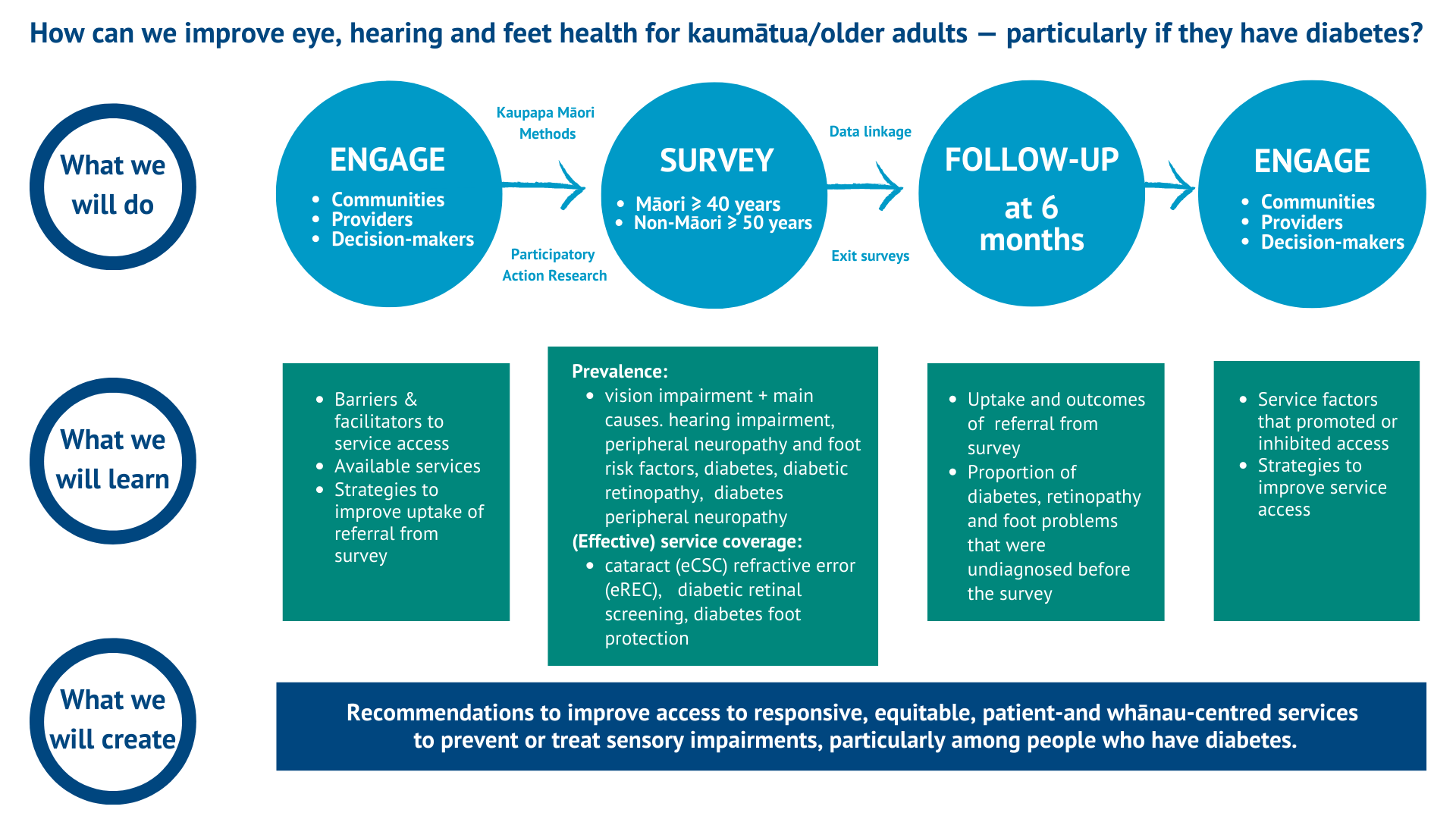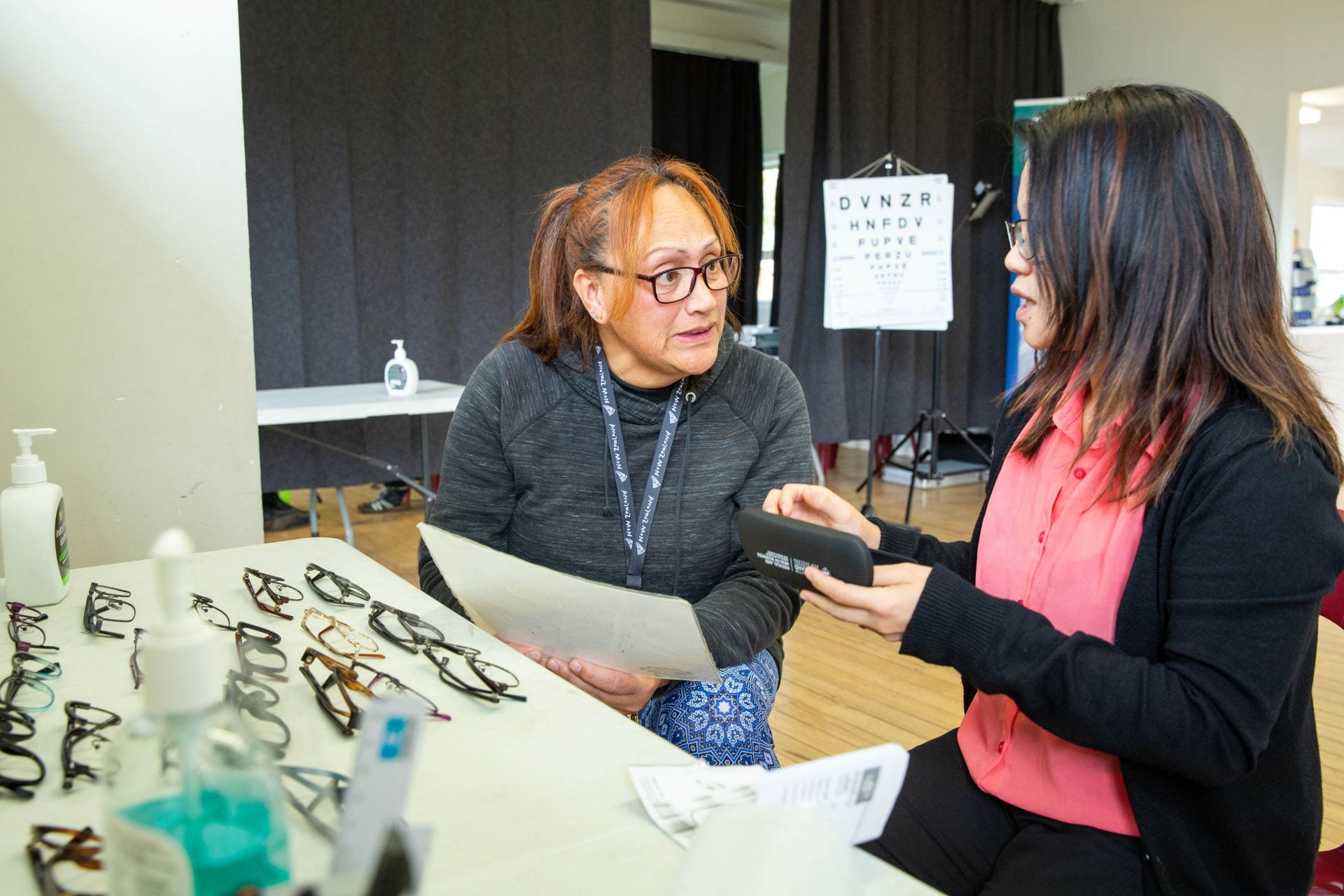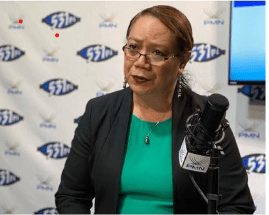
Population health survey
Improving knowledge and understanding of eye health in AotearoaIn 2024, New Zealand will begin its first population-based eye health survey. The survey is part of a multi-disciplinary project that aims to promote healthy ageing in New Zealand, with a focus on improving access to health services for people living with eye, hearing, or foot problems, particularly if they also have diabetes.
Why a survey?
There has not been a population-based survey of eye health in Aotearoa New Zealand. This means that we don’t know how many people are living with vision loss, and we do not have enough information to plan and deliver equitable eye care services.
Eye health services are not accessible to all New Zealanders, with Māori and Pacific people particularly under-represented among those able to access the services that they need.
When eye health services are not accessible, people experience preventable or treatable vision loss, and miss out on opportunities to participate fully with whānau, or in everyday activities such as driving, working, and learning.
By completing this project, we will understand how many people need eye care services, and how we can make them more accessible to everyone.
What are we doing?
The survey will estimate how many adults in Aotearoa live with vision impairment as well as its main causes, along with estimates for people living with hearing loss, foot problems, and diabetes. The survey will also estimate the extent to which people are accessing the health services that they need for these conditions.
This work is a collaboration between the Community Eye Health team and researchers with clinical expertise in audiology, podiatry, primary care, and diabetic medicine, as well as methodological expertise in Kaupapa Māori research, epidemiology and biostatistics. The research team will work closely with communities, service providers, professional associations and training institutions.
Who are we surveying?
The sample will be drawn from residents of Northland, Counties Manukau, Tairāwhiti, and Lakes who are 40 years and above (for Māori), or 50 years and above (for non-Māori).
This difference in the age profile of recruited participants is because some health conditions typically begin at an earlier age for Māori compared to non-Māori.
What is involved?
Our researchers will visit people in their homes to ask if they would like to participate in our survey. Participants will receive testing of their vision, hearing, and foot health, as well as a diabetes test, and they will be asked about their general health and wellbeing.
People who need further testing or treatment will be referred to the health services that they need. After six months, we will measure how many people were able to access this care, whether they faced any challenges, and what impact this care has had on their wellbeing.
Prior to the survey commencing, researchers will engage with communities and service providers in each study region to explore the provision of diabetes, eye, hearing, and foot services. The team will take survey findings back to communities and service providers to help identify service factors that promoted or inhibited access and to recommend how to improve access and outcomes.
What do we already know?
In July 2021, we began a pilot eye health survey in the Glen Innes, Panmure and Ōrākei areas of Auckland. This was an important step in preparing for our population-based study.
This early work gave us a snapshot of eye health needs among three population groups living in this area: Māori and Pacific people aged 40+ years, and other New Zealanders aged 50+ years.
We observed large unmet need in this community. While many people had distance or near vision impairment, many also expressed difficulty in accessing eye care and obtaining custom-made spectacles to correct their vision.
The pilot study helped us understand the barriers that prevent people from participating in surveys like ours. By recruiting people door-to-door and discussing their concerns, we now have a better understanding of how to reach and recruit people from different population groups.
Testing our survey on a small group of people also gave us an opportunity to work with different researchers, clinicians, and community groups. It showed us how important a collaborative approach will be, as we embark on our full survey.
Judith, a survey participant, talks about her eye health, while visiting the pop-up eye clinic at Te Whare Piringa community centre in Glen Innes.
Behind the scenes of the Community Eye Pilot Study
In July 2021, the Community Eye Health team conducted a pilot eye health survey in the Glen Innes, Panmure and Ōrākei areas of Auckland. This survey gave us the opportunity to collect information about the state of eye health in a small group of New Zealanders,...
A view from the Pacific: a conversation about eye care with Telusila Moala-Mafi Vea
A pilot eye health survey and eye exams in East Central Auckland (Orakei, Panmure and Glen Innes) on Maori and Pacific people uncovered significant unmet need among three population groups living in this area. Telusila Moala-Mafi Vea is the Community Survey...
NZ Optics: Door-knock study uncovers unmet need
Auckland University researchers have conducted a pilot eye health survey and community eye exams in east-central Auckland, uncovering significant unmet need and serious eye disorders, including retinal tears and severe cataracts. Read the full story in the...
Research team

Jacqui Ramke
Associate Professor

Pushkar Silwal
Research Fellow

Jaymie Rogers
PhD candidate

Claire O'Shea
Podiatrist & PhD candidate

Deborah Ewuru
PhD candidate
Collaborators
This multi-disciplinary project is a collaboration between researchers and health professionals across optometry, audiology, and beyond. Some of our collaborators involved in this project include:
School of Population Health, The University of Auckland:
Associate Professor Matire Harwood, Dr Arier Lee
School of Medicine, The University of Auckland:
Professor Rinki Murphy
Department of Audiology, The University of Auckland:
Dr Alehandrea Manuel
Te Whatu Ora:
Michele Garrett, Tarati Blair-Hunt
London School of Hygiene and Tropical Medicine:
Associate Professor Islay Mactaggart
Funding
The project is funded by a HRC Project Grant, with co-funding from Blind Low Vision NZ, the NZ Association of Optometrists, and the Buchanan Charitable Foundation.
We are also excited about our partnership with Te Tohu Paetahi Tikanga Rangatira aa-Tapuhi (Bachelor of Nursing Māori) at Manukau Institute of Technology that will see students join our research team.
Supporters of our pilot survey
The Community Eye Health research team would like to acknowledge The University of Auckland and the Buchanan Charitable Foundation for their support of the pilot study.
We would also like to thank Peter and Rae Fehl, Blind Low Vision New Zealand and New Zealand Association of Optometrists for funding eye tests for eligible participants.
To ensure all participants with vision impairment are able to access glasses, we are using the SOVS Community Spectacle Scheme, which is supported by Helen Blake, Barbara Blake and Essilor.




